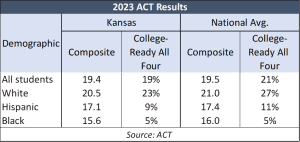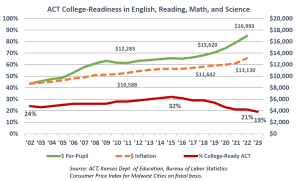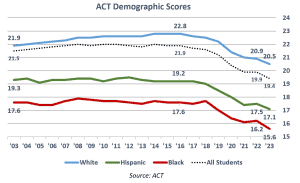(The Sentinel) — A little more than a week after the Kansas Association of School Boards touted Kansas as one of only six states which did not see a decline in ACT scores between the 2020-21 and 2021-22 school years, the 2023 ACT scores have been released — and the news is not good.
At a hearing of the Kansas Legislature’s Special Committee on Education Oct. 2, KASB Communications Editor Scott Rothschild pointed out the steady scores — while failing to note the 2021-22 results were the worst in 30 years.
Until now.
The 2023 scores are in and Kansas has seen a composite three-point drop in college readiness.

Before this latest drop in scores, 21 percent — below the national average — of Kansas students were considered “college ready” by ACT in English, Reading, Math, and Science. This marked a decreased from a high of 32 percent in 2015. At the end of the 2022-23 school year, only 19% are college ready, with the national average at 21%.
Indeed, in 2023 Kansas is tracking below national average in the major demographic groups as well. ACT tracks scores based on racial demographics whereas as some other assessments rely on income or other variables.
About 23% of White students were college ready in Kansas compared to the national average of 27%. Nine percent of Hispanic students in Kansas were college ready, compared to a national average of 11%, and only 5% of Black Students were prepared to go to university, which is consistent with the national average. None of these scores should be worthy of celebration and the gaps between demographics groups is something that multiple legislative committees have reviewed over the years.
At that same hearing KASB’s Rothschild claimed school spending had only recently exceeded the rate of inflation.
“Kansas funding was below inflation and takes a real dip from 2009 to 2015,” he said. “Total Kansas funding dropped from 98% of the U.S. average in 2009 to 88% in 2019. Over that period Kansas NEAP scores fell from above the U.S. average to about the same as the U.S. average. Kansas began increasing school funding more than inflation in 2018 under the 6-year funding plan in response to Gannon but as you can see we are still below the national average by about 10% and we are just about the regional average.”
But as the graph below shows, per-pupil spending in Kansas had been growing faster than the rate of inflation in 2006 and has stayed steadily above it ever since, despite the dip Rothschild describes, which coincided with cuts initiated by former Democratic Governor Mark Parkinson; Parkinson concluded Gov. Sebelius’s term that ended in January 2011. Adjusted for the cost of living (a dollar spent in Kansas buys a lot more than a dollar spent in New York), per-student spending in Kansas is the 9th-highest in the nation.

Moreover, the scores started trending down around 2016 — roughly the time the “Kansas Can” standards were published by the Kansas State Department of Education, which prioritize “Social Emotional Learning” over academic achievement.

Kansas State Rep. Kristey Williams, who chairs the Special Committee on Education said the 2023 ACT scores were discouraging.
“Just as we are encouraged by improvements with state assessment scores, we are simultaneously discouraged by record lows on the ACT,” she said. “For our students to be career and college ready, we’ll need laser focus on fundamentals to ensure all graduates can read, write, and do math at levels that afford them the best opportunity for success. The Legislature will continue to look for ways to support students and improve outcomes.”
The Sentinel reached out to KASB, KSDE and the Kansas National Education association asking for a response to the 2023 ACT scores, but as of publication has not received a response.

